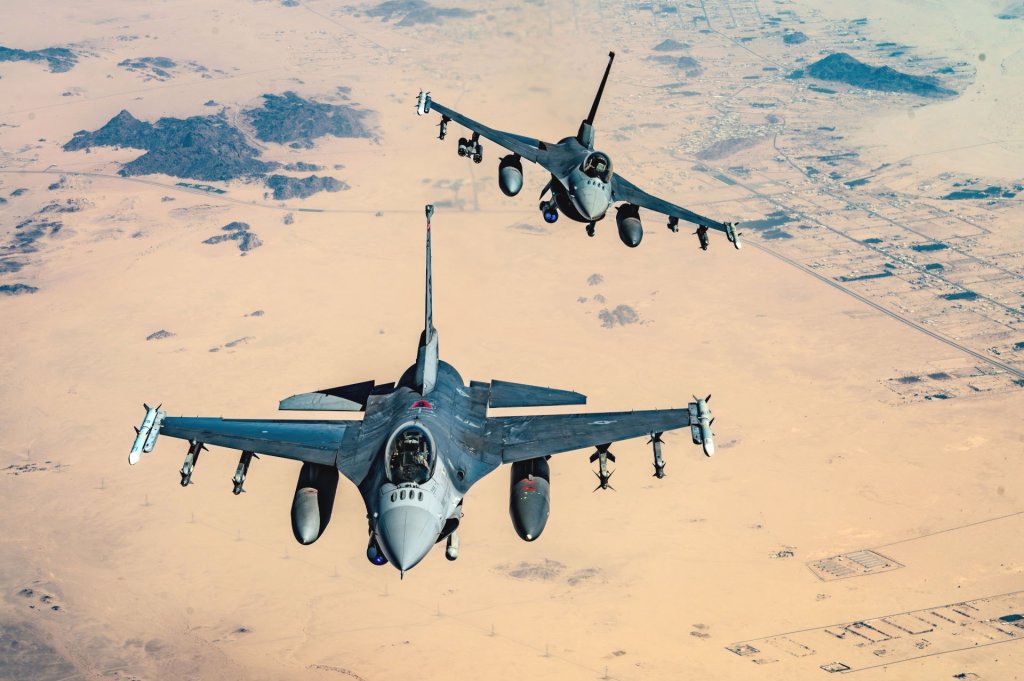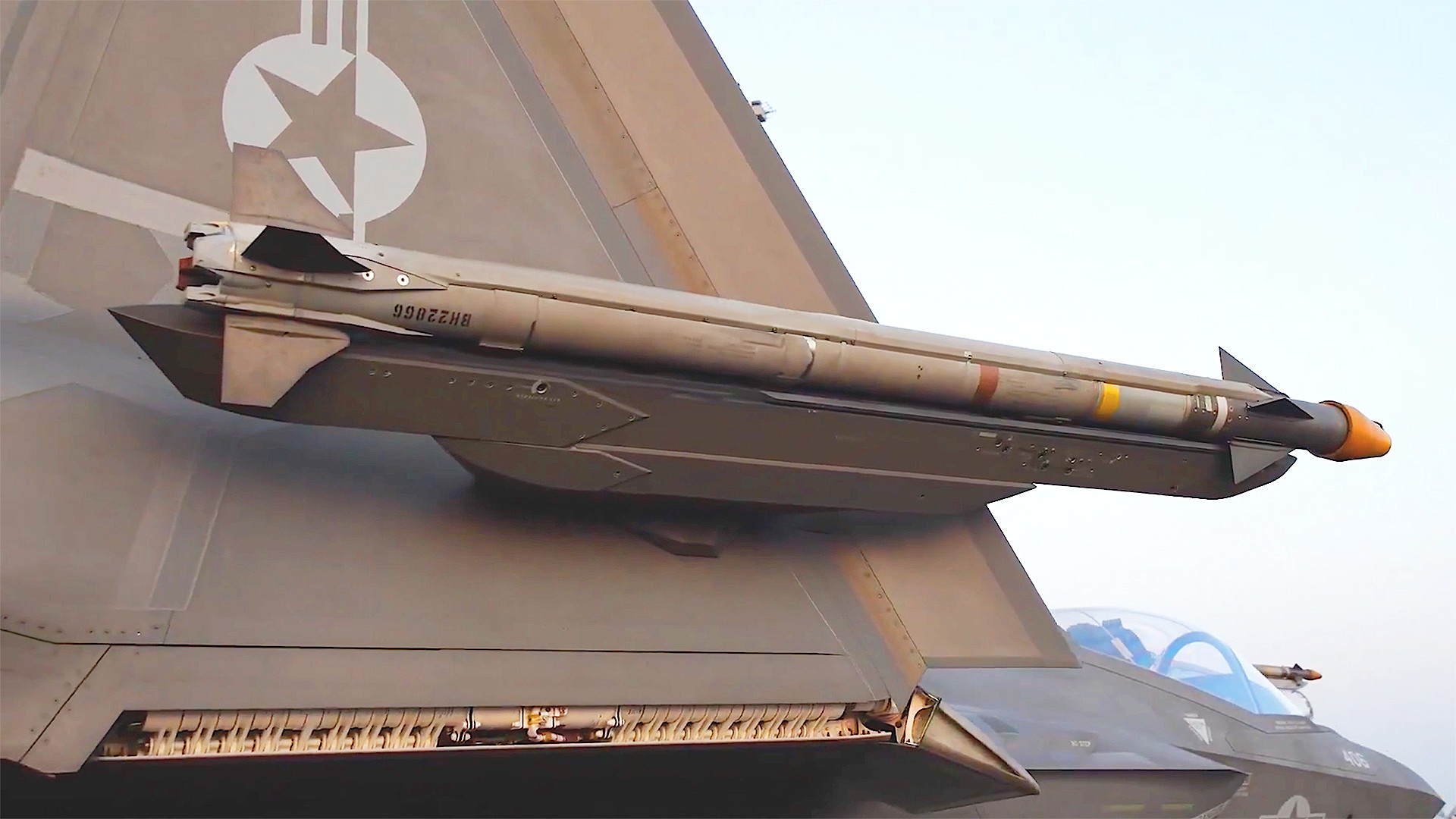U.S. carrier-based F-35C Joint Strike Fighters have been shooting down Houthi drones in the course of recent operations over and around the Red Sea, in addition to striking targets in Yemen, according to a U.S. official. The disclosure comes amid an evolving U.S. aerial campaign in the region, in which the threats posed by the Yemeni militants’ air defense capabilities have become an increasingly pronounced factor, as TWZ just explored this week in a highly detailed feature.
TWZ had first reached out about the possibility of F-35Cs being employed against Houthi drones after the Pentagon released a video, seen below, showing one of the jets aboard the supercarrier USS Carl Vinson with a live AIM-9X Sidewinder missile loaded on its right wing.
The U.S. official told TWZ that F-35Cs assigned to Navy carrier strike groups have downed Houthi drones at least since the beginning of this month, when the supercarrier USS Carl Vinson arrived in Middle Eastern waters. A Navy F-35C squadron – Strike Fighter Squadron 97 (VFA-97), the “Warhawks” – is part of the air wing currently embarked on Vinson. A second carrier, the USS Harry S. Truman, is also operating in the region, but its air wing does not contain F-35Cs.

Whether or not Marine F-35Cs assigned to the USS Abraham Lincoln shot down any drones while that carrier was deployed in and around the Red Sea last year is unknown, and TWZ has reached back out for more information. Imagery released at the time showed some F-35Cs from Marine Fighter Attack Squadron 314 (VMFA-314), the “Black Knights,” flying combat sorties with underwing launch rails for AIM-9Xs installed, but without any missiles loaded on them. Though not conclusive, this could be a clue to the Marine jets having participated in counter-air duties.

F-35Cs, like all other Joint Strike Fighter variants, can also carry AIM-120 Advanced Medium-Range Air-to-Air Missiles (AMRAAM), as well as various air-to-ground munitions, in their internal weapons bays. The F-35C and the F-35B can also be equipped with gunpods containing a single four-barrelled 25mm Gatling-type GAU-22/A cannon, which can be employed against aerial targets and ones down below. F-35As have built-in GAU-22/As, a configuration that has suffered significant issues over the years, as you can read more about here.
The U.S. official also reconfirmed that carrier-based F-35Cs have been participating in strikes on Houthi targets in Yemen, something the Pentagon first disclosed in November 2024.
It is also not known whether or not F-35Cs shooting down Houthi drones represent the first air-to-air victories for U.S. Joint Strike Fighters of any type. Israeli F-35Is have already been downing drones, as well as cruise missiles, for years now.
Carrier-based F/A-18E/F Super Hornets and EA-18G Growlers belonging the Navy, as well as U.S. Air Force F-16C Vipers flying from bases on land in the region, have also downed drones, as well as cruise missiles, in the course of ongoing operations against the Houthis. The Navy jets have also sometimes been tasked to perform counter-air duties even when it’s not their primary mission.
The basic fact that U.S. F-35Cs are now being regularly employed on combat missions in the Red Sea is an important milestone for the type. The F-35C was the last of the Joint Strike Fighter variants to reach initial operational capability, with the Navy announcing it had done so in 2019. The jets only began deploying on Navy carriers in 2021.
It’s also worth noting here that work is ongoing to enable F-35Cs, as well as A variants, to carry six AIM-120s internally, rather than just four, with the help of a device called Sidekick. The system, unfortunately, will not work with the internal bays on the F-35B variant, which are smaller due to the large lift fan behind the cockpit, one of several features unique to the short takeoff and vertical landing-capable jets.
Plans have also been laid out in the past to allow for all versions of the Joint Strike Fighter to carry additional AIM-120s on their underwing pylons, but it is unclear whether or not that is an operational loadout option now. An F-35 carrying any stores under its wings does come at the cost of some of the jet’s low-observability (stealthiness).

Ongoing operations against the Houthis, as well as U.S. participation in the defense of Israel against multiple rounds of large-scale Iranian missile and drone attacks last year, have highlighted the value of additional magazine depth. The crew of at least one Air Force F-15E Strike Eagle switched to guns after running out of missiles while responding to Iran’s missile and drone barrage in April 2024, but was unsuccessful in bringing anything down.
Starting last year, U.S. Air Force F-16C Vipers have notably been using 70mm laser-guided Advanced Precision Kill Weapon System II (APKWS II) rockets to down drones on missions over and around the Red Sea, which TWZ was first to report on. We have also now seen Vipers flying in the region with loadouts that include two seven-shot 70mm rocket pods on a single pylon, which more than triples the number of total engagement opportunities for the aircraft on a single sortie.

APKWS II rockets, which have unit costs in the low tens of thousands of dollars, depending on their configuration, also offer a valuable lower-cost option for engaging less dynamic targets like drones and cruise missiles. Current generation versions of the AIM-9X and AIM-120 each cost around $450,000 and $1 million, respectively. APKWS II is not currently cleared for use on any F-35 variant, even from external underwing pylons, and it is unclear whether the Navy may be moving to integrate it onto its Super Hornets.
A new dual-mode version of the APKWS II with an additional infrared seeker is now in development, which will further expand its capabilities, especially in the air-to-air role. Demand for cheaper anti-air munitions is growing across the U.S. military, in general, due in large part to drone threats.
As for the F-35Cs downing Houthi drones, the news comes amid an expanded aerial campaign against the Yemeni militants that President Donald Trump’s administration kicked off last month and that has been exposing some hard truths. This includes the real threats posed by the air defense capabilities available to the Yemeni militants, which TWZ just explored in great detail in a feature published this week. The United States looks to have lost at least 18 MQ-9 Reaper drones to the Houthis so far, and possibly more, including seven downed just since the beginning of March.
Houthi air defenses have been “hindering the US’ ability to move into ‘phase two’ of the operation,” according to a report from CNN just today, citing unnamed U.S. officials. “The US was hoping to achieve air superiority over Yemen within 30 days, officials said, and degrade Houthi air defense systems enough to begin a new phase focusing on ramping up intelligence, reconnaissance, and surveillance of senior Houthi leaders in order to target and kill them.”
TWZ has previously noted how an uptick in the use of standoff munitions against targets in Yemen, as well as the employment of stealthy aircraft like F-35s and B-2 bombers, has also pointed to Houthi air defense capabilities presenting greater challenges than have been widely appreciated. Another video that U.S. Central Command (CENTCOM) released on Monday notably showed a U.S. Navy EA-18G Growler armed with a rare load of four AGM-88 anti-radiation missiles, highlighting ongoing efforts to suppress and destroy the Yemeni militants’ anti-air assets.
The F-35C could be proving particularly valuable in the current campaign, given their unique survivability among aircraft in the Navy’s current carrier air wings. The naval Joint Strike Fighters could be used to launch direct attacks in areas that might otherwise require the use of standoff munitions to reduce risk. At the same time, sending F-35s into more heavily defended areas could create different risks, especially if one of the aircraft were to go down for any reason. Launching a combat search and rescue mission to recover the pilot in that scenario would require sending significant resources into that same more contested environment.
Regardless, U.S. officials have contended that operations against the Houthis have still been able to significantly degrade the group’s ability to launch drone and missile attacks, including against commercial vessels and warships sailing in and around the Red Sea, per reports from CNN and Fox News.
“Since the start of operations against the Iranian-backed Houthi terrorists, USCENTCOM has struck over 800 targets. These strikes have destroyed multiple command-and-control facilities, air defense systems, advanced weapons manufacturing facilities, advanced weapons storage locations, and killed hundreds of Houthi fighters and numerous Houthi leaders,” Dave Eastburn, a spokesperson for the command, told Fox News. “Credible open sources report over 650 Houthi casualties to date. Additionally, Houthi ballistic missile launches have dropped by 87% while attacks from their one-way drones have decreased by 65% since the beginning of these operations.”
Separately, Air Force Maj. Gen. Joseph Kunkel said during a virtual talk that the Air & Space Forces Association (AFA) hosted yesterday that his service is already learning important lessons from the air campaign against the Houthis. Kunkel is currently the director of Force Design, Integration, and Wargaming within the office of the Deputy Chief of Staff for Air Force Futures at the Pentagon.
“The fight in Yemen right now, that is an air campaign. It is an air campaign,” Kunkel stressed. “How we conduct that air campaign, with a set of capabilities that are performing interdiction, that are performing counter-air, that are performing this counter-IADS-like mission – we need to think differently about how those things are coming together.”
IADS here refers to integrated air defense systems typically associated with the armed forces of nation states rather than non-state actors like the Houthis.
The Navy has also made clear that it has been seeing significant lessons learned, including when it comes to maritime operations, from operations against the Houthis, something TWZ predicted would be the case more than a year ago. The issues that the current campaign has highlighted, including around magazine depth and air defense threats, would be even more pronounced in a future high-end fight against a near-peer competitor like China.

If nothing else, we have now been told that the role of carrier-based F-35Cs in the current campaign against the Houthis has expanded to shooting down the group’s drones, as well as targeting its assets on the ground in Yemen.
Howard Altman contributed to this story.
Contact the author: joe@twz.com
